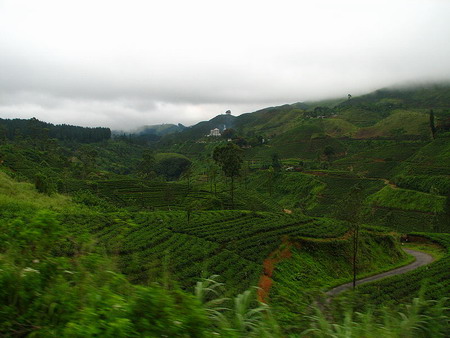Tea production in Sri Lanka, formerly Ceylon, is of high importance to the Sri Lankan economy and the world market. The country is the world's third largest producer of tea and the industry is one of the country's main sources of foreign exchange and a significant source of income for laborers, with tea accounting for 15% of the GDP, generating roughly $700 million annually.
Sri Lanka was the world's leading exporter of tea (rather than producer) with 23% of the total world export in 1995 but has since been surpassed by Kenya. The tea sector employs, directly or indirectly over 1 million people in Sri Lanka, and in 1995 directly employed 215,338 on tea plantations and estates.
The central highlands of the country, low temperature climate throughout the year, annual rainfall and the level of humidity are more favorable geographical factors for production in high quality tea. The industry was introduced to the country in 1867 by James Taylor, the British planter who arrived in 1852.
|

Tea plantation in the Sri Lankan central highlands. [Wikipedia]

|
Ceylon green tea
Ceylon green tea is mainly made from Assamese tea stock. It is grown in Idalgashinna in Uva Province. Ceylon green teas generally have the fuller body and the more pungent, rather malty, nutty flavour characteristic of the teas originating from Assamese seed stock. The tea grade names of most Ceylon green teas reflect traditional Chinese green tea nomenclature, such as tightly rolled gunpowder tea, or more open leaf tea grades with Chinese names like Chun Mee. Overall, the green teas from Sri Lanka have their own characteristics at this time - they tend to be darker in both the dry and infused leaf, and their flavour is richer; this could change in the future as market demand preferences change the Ceylon green tea producers start using more of the original Chinese, Indonesian, Japanese and Brazilian seed base, which produces the very light and sparkling bright yellow colour and more delicate, sweet flavour with which most of the world market associates green teas. At this time, Sri Lanka remains a very minor producer of green teas and its green teas, like those of India and Kenya, remain an acquired taste.
Ceylon white tea
Ceylon white tea, also known as "silver tips" is highly prized, and prices per kilogram are significantly higher than other teas. The tea was first grown at Nuwara Eliya near Adam's Peak between 2200 -2500 metres. The tea is grown, harvested and rolled by hand with the leaves dried and withered in the sun. It has a delicate, very light liquoring with notes of pine & honey and a golden coppery infusion. 'Virgin White Tea' is also grown near Galle in the south of Sri Lanka. The history of this tea is that the tea was specially made for the Chinese Emperor and was only cut by virgins with golden shears onto golden plates and was never touched by hand. The anti oxidants found in the tea are over 10% which ranks it one of the highest in the World.
Ceylon black tea
Ceylon black tea is one of the country's specialties. It has a crisp aroma reminiscent of citrus, and is used both unmixed and in blends. It is grown on numerous estates which vary in altitude and taste.

